This post may contain affiliate links. Read more at our disclosure policy.
The Best Smoked Salmon recipe ever! This easy recipe uses a quick dry brine and hot smoking process to get tender and flavorful smoke flavor (versus salmon jerky). And I’m not talking about lox, which uses cold-smoking techniques and a longer cure process. Discover how to make tender smoked salmon every time using this tried and true recipe.
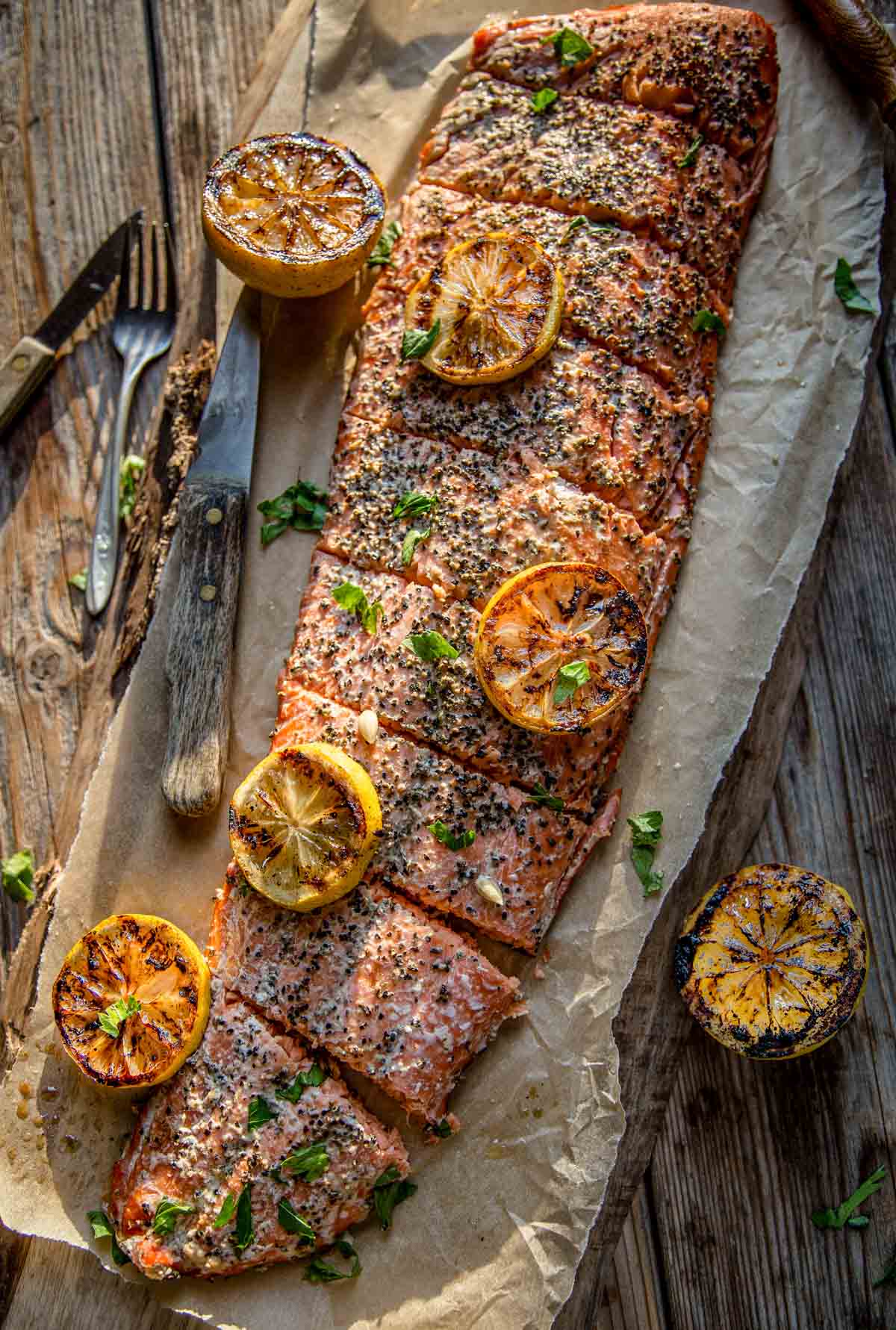
This easy smoked salmon recipe has given us the best results when catering events and does not need a wet brine, which adds more time to preparation. Read on for more details and our video tutorial.
Salmon is one of my favorite things to cook on the smoker or grill. But too often salmon gets a bad rap for being overcooked. Hot-smoked salmon is about setting a low temperature and not overcooking the salmon. Add a simple seasoning and you get the perfect salmon every time.
Recipe Highlights
- Simple seasoning with Dijon mustard, salt, and pepper.
- Source fresh salmon for the best flavor.
- There is no need for a salmon brine using the Dijon mustard to form the pellicle.
- You can use this same recipe for Steelhead, which is very similar to salmon. Follow our other recipe If you are smoking sockeye salmon which is a smaller salmon.
Table of Contents
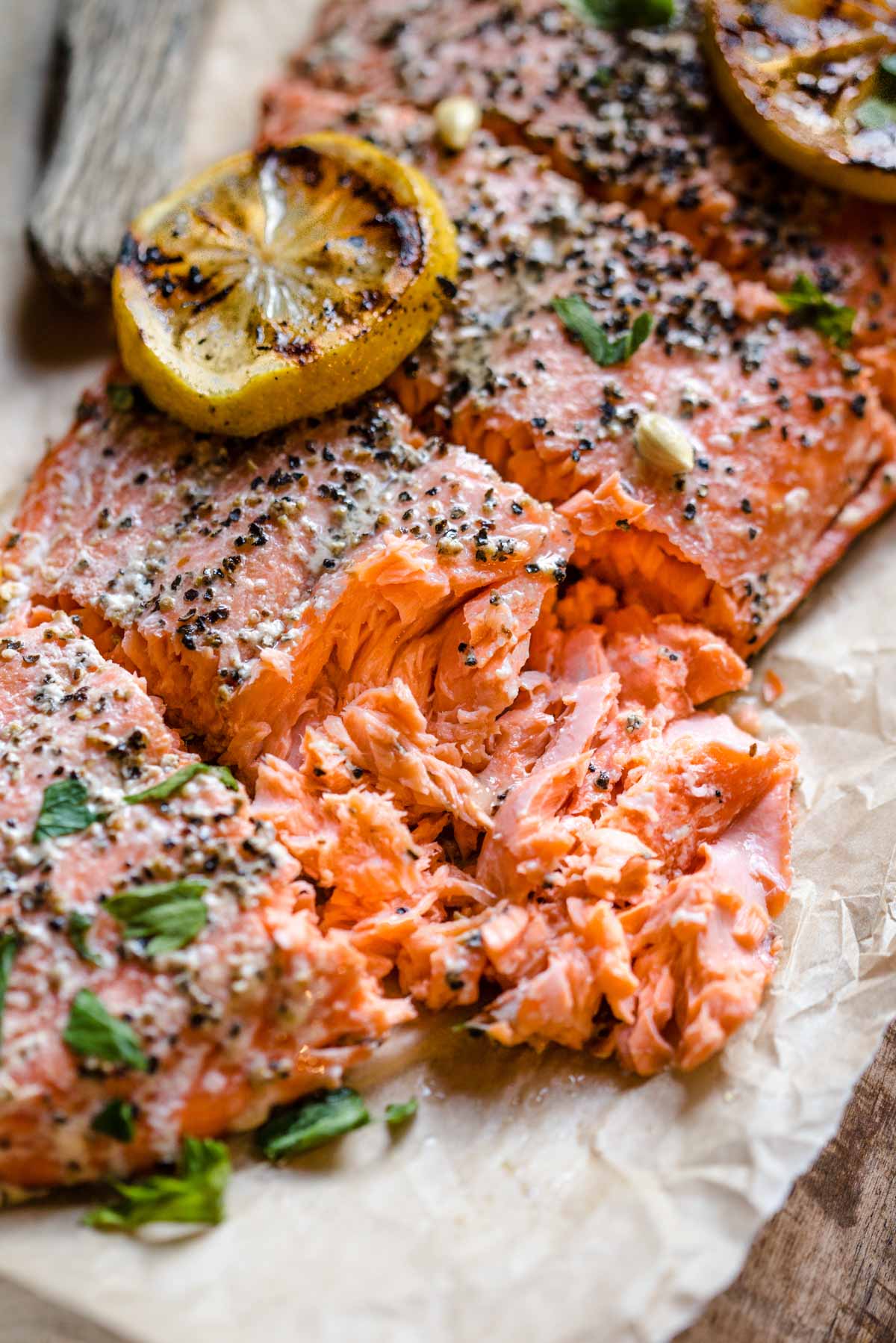
There’s a good reason that smoked salmon is one of the top requests we get for Ember & Vine catering events (our catering company). And we always hear the same comment over and over: that it’s the best salmon people have ever eaten. The secret? Using good quality salmon, and not overcooking it.
That’s it.
Recipe Ingredients
- Salmon Filet – Buy an entire salmon filet for a crowd. We used a King Salmon, or Chinook Salmon, which is much thicker and requires a longer cooking time. If using a smaller variety like Coho or Sockeye then lower your cooking time as it will cook faster.
- Mustard – Mustard acts as a binder for the seasoning.
- Seasoning – We use kosher salt and coarse black pepper to allow the salmon flavor to shine.
Buying Salmon
The best salmon is going to be fresh and should have a vibrant pink color and little to no odor. Different types of salmon will have different levels of fat content, which changes the cooking time.
- Farm Raised – This is salmon raised in a farm or open water pen. Often you’ll find that the fat content is much higher and they will be bigger. This is because they arguably don’t need to work as hard, so they slowly hang out in these large water pens. These are great for smoking as the fat content is very forgiving and makes for very tender and juicy salmon. Look for Columbia River King (King Salmon) or Atlantic salmon most commonly.
- Wild-Caught Salmon – From the wild, this is salmon that has been swimming in its natural habitat. When you watch the videos of salmon swimming upstream you can see quickly why these are much leaner than their farmed cousins. These are great for grilling hot and fast, but can also be smoked. If you smoke a wild-caught, just know it may not have as much fat and will cook much faster. We prefer wild salmon for several reasons. The biggest reason is the flavor. Look for Columbia River King (otherwise known as Chinook), Coho, Copper River, Sockeye Salmon, and others.
- Either way, it should be fresh — Smell it and check the eyes if buying a whole fish. It should not smell “fishy”, and the eyes should be relatively clear. An overly fishy smell or eyes that are glazed and frosted are indications of a not-so-fresh piece of fish.
Also, consider using an entire salmon fillet. Good salmon will go quickly with a crowd, and frankly having a multiple-pound salmon fillet on your smoker is an awesome conversation piece. Even if you’re cooking for a small family, there are excellent uses for any leftovers (see the end of this post for a few ideas!).
Preparation
- When buying your salmon fillet, ask the fish monger to take the pin bones out. These run along the top of the fish. These can be removed using tweezers yourself if the butcher or fish monger is unable to do it for you, but trust me, ask them to do it for you.
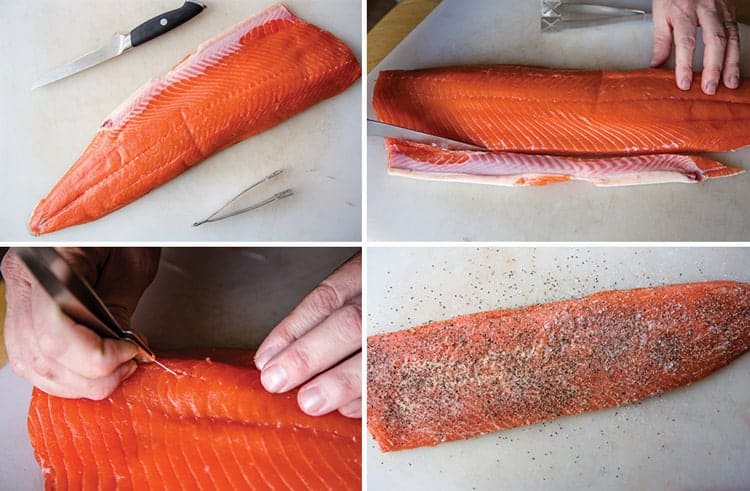
- Trim off the belly, we find a natural line that contours the fish. This allows us to cook that separately as a snack. The belly has some cartilage and membrane that is easier to remove and then cook with the salmon.
- On the salmon skin side, be sure to use a knife against the scales, scraping it (not cutting it) to de-scale it. A lot of times this too is already done if you buy from a grocery store but default to that as a practice.
- Pat dry with a paper towel to remove the excess scales and bones from prep. Then you can season and smoke it.
Seasoning
The goal is dry brining and using Dijon mustard to form a pellicle (see below for more detail) on the surface of the fish. Start with a coating of Dijon mustard. Then add kosher salt and pepper over the flesh side. Alternatively, you can use our seafood seasoning as a dry rub for more flavor.
If seasoning in advance, season on a sheet tray and store covered with plastic wrap in your refrigerator until ready to cook.
The Pellicle is a layer, or coating of protein, that is most commonly found in wet-brined salmon. It helps to form a harder coating that allows the proteins to stay inside the salmon and still take on smoke.
How to Smoke Salmon
- Start by prepping your smoker to 225 degrees (F) using fruit wood (we find the best wood for salmon is cherry or apple wood).
- Place salmon on the smoker and close the lid. Smoke until it hits your desired internal temperature. For tender salmon, we cook it to 135 degrees Fahrenheit. You’ll see the salmon sweating out proteins, and you’ll see a nice red color start to form on the crust of the salmon. Check the temperature at the thickest part with an instant-read meat thermometer. You can also poke and pull apart the flaky salmon and make sure that the interior is pink and not translucent.
- The amount of time will vary when smoking, but a typical 2-pound filet should take roughly one hour.
Pro Tip: Start checking temperature early. The smaller the fillet, or if using wild caught, start checking the internal temperature as early as 30 minutes.
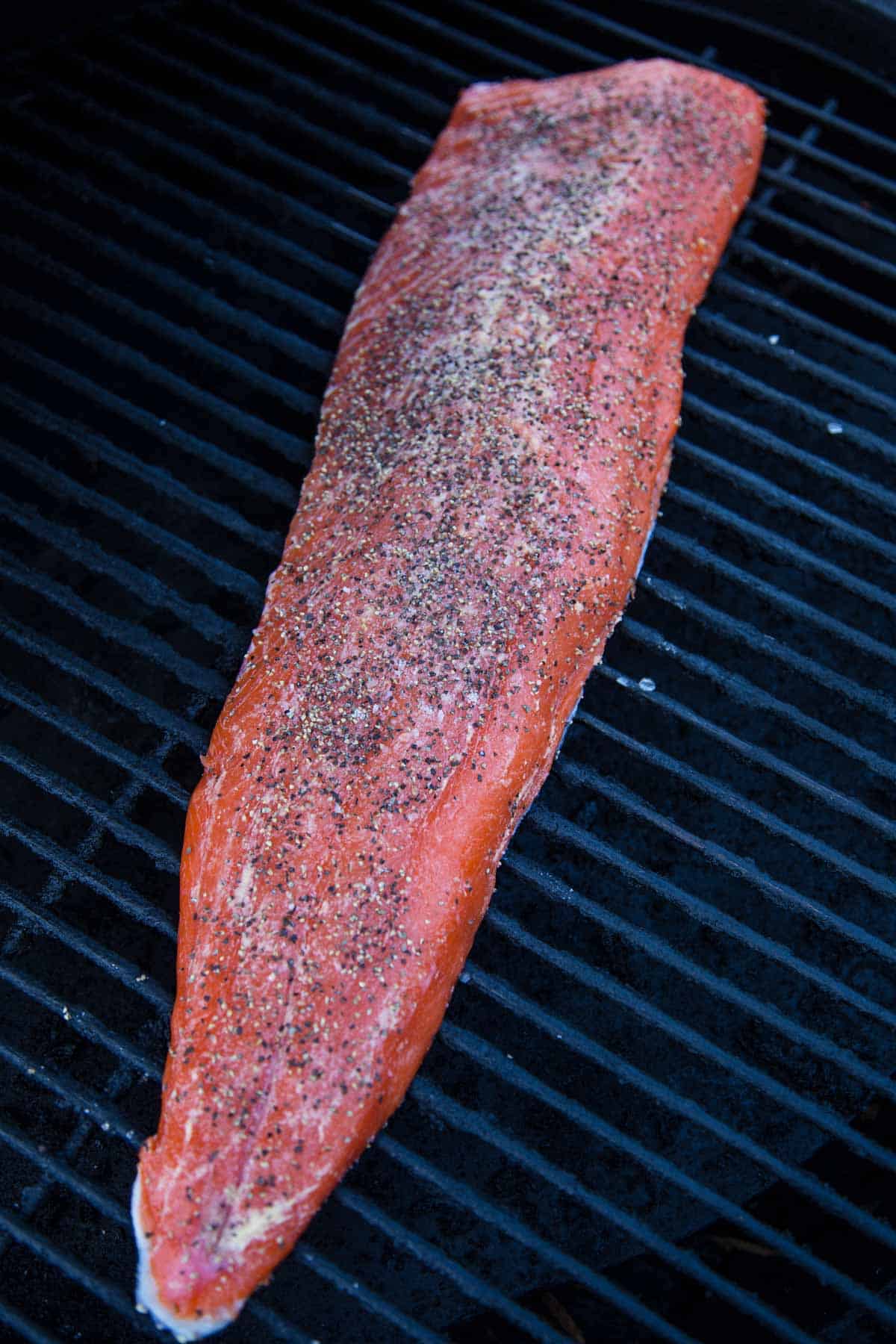
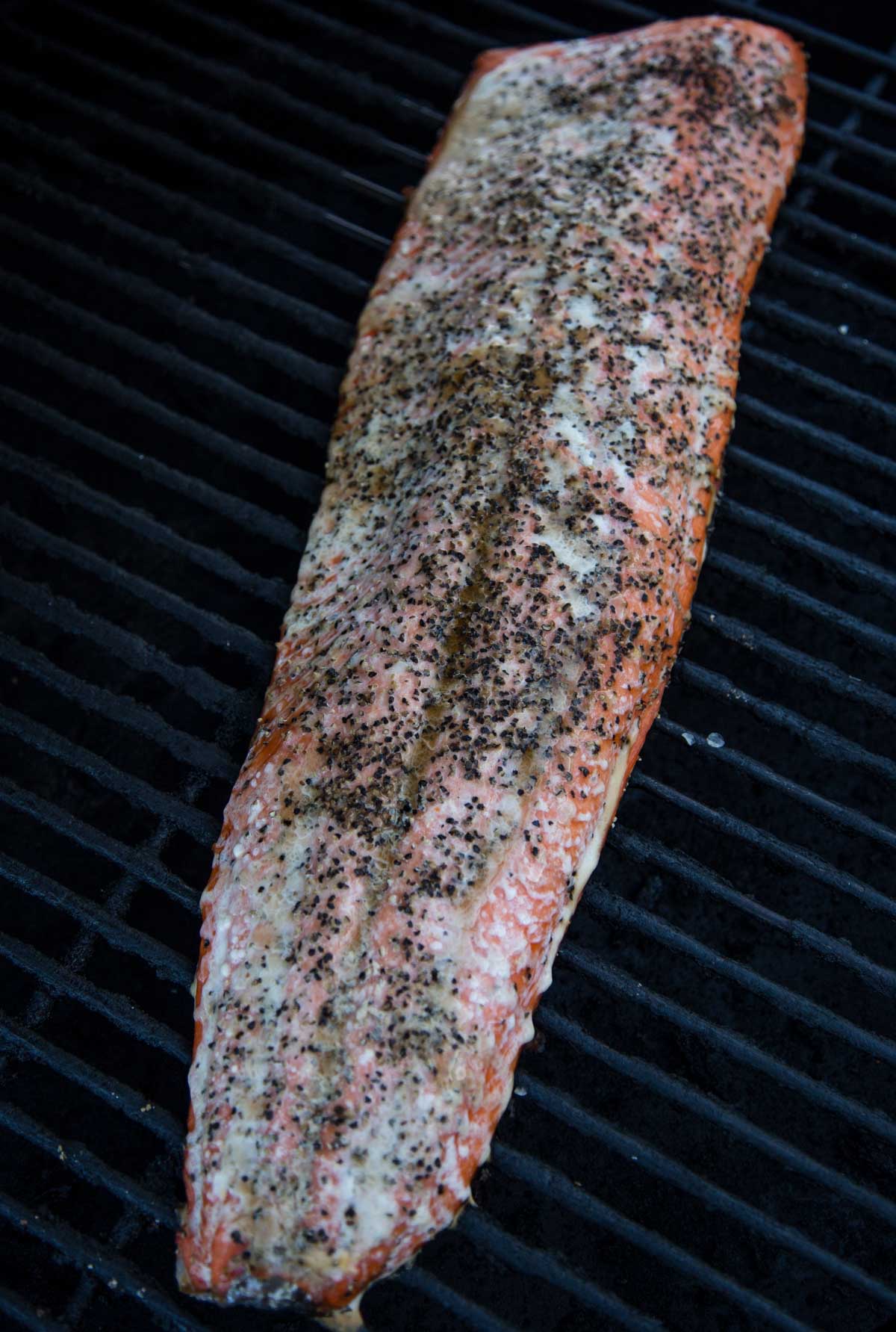
The key to tender juicy salmon is cooking it at a low heat and paying close attention to the internal temperature using a good quality digital instant read thermometer.
Would you like to save this?
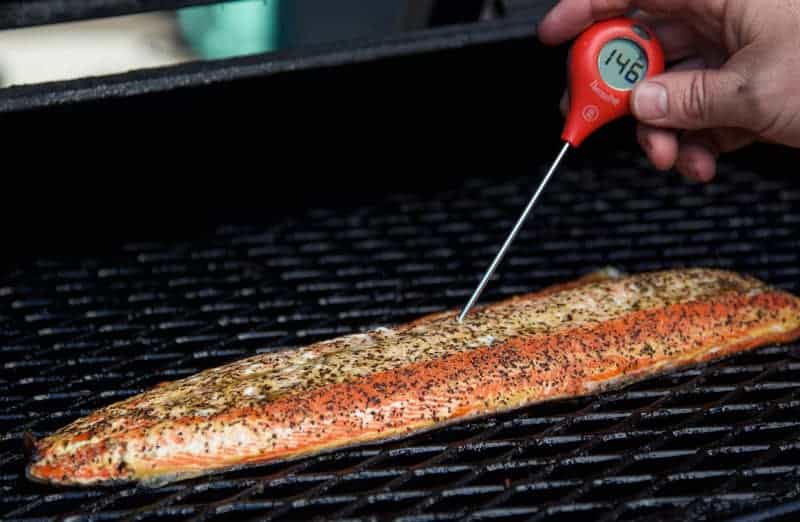
Frequently Asked Questions (FAQ)
According to the USDA Salmon should be cooked to 145 degrees (F). If you are concerned about food safety, then cook the meat to the recommended temperature. However, we cook ours to an internal temperature no greater than 135 degrees because we trust our sourcing and know it is of high quality. Therefore we trust it cooked to medium.
Carry-over cooking will take the internal temperature of the salmon an additional 5 degrees.
This will vary depending on the exact size of the salmon and the exact temperature of the smoker. For a 1 – 1 1/2 pound salmon it should be done within the first hour. Always cook to temperature, not exact time.
No, you do not need to brine salmon for flavor or added moisture. Cooking it using this method will have incredibly flavorful and tender results. If you want to brine, keep it simple with kosher salt, water, and brown sugar. But it is not necessary.
Follow the same process as the recipe instructions. You can adjust the temperature down using smoke or 180 for more smoke flavor.
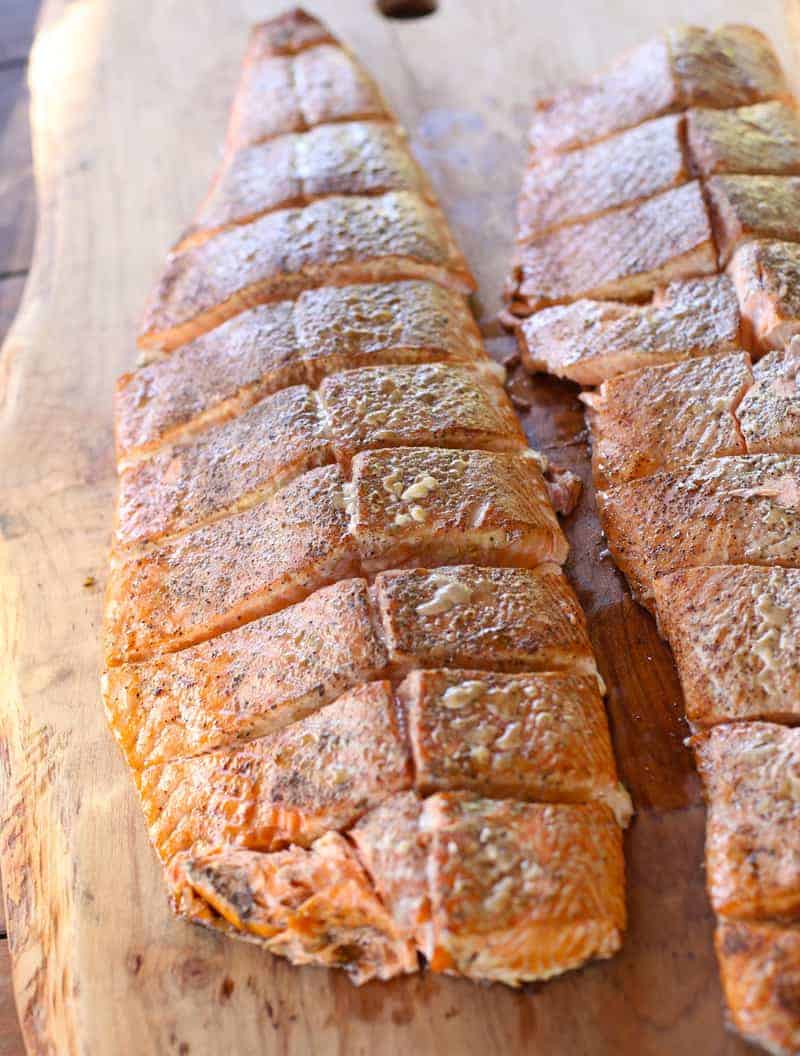
Expert Tips
- Portioning Filet: Prior to smoking if you want to pre-portion out the filet, run a sharp knife lengthwise along the salmon filet taking care to not cut through the skin. Then make small cuts horizontally. Then season and cook. When it is done, you can have your servings pulled right off using a spatula.
- Steelhead: You can also use this recipe for steelhead, it will cook in the same way.
Storage and Reheating Instructions
The salmon will last for up to three days in the refrigerator.
If reheating leftovers the best method is the following.
- Preheat oven to 325 degrees F. Place a cookie drying rack inside a sheet tray. Pour a small amount of water into the bottom of the tray. Be sure the water doesn’t reach the salmon (this is just to add some humidity).
- Place salmon filets on the drying rack and cover with foil. Place in the preheated oven for up to 8 minutes. The water will help steam and keep the salmon tender.
- Remove and serve.
What To Serve With Smoked Salmon
Explore some of our favorite side dishes for salmon or check out all of our side recipes.
- Garnish – We love adding freshly chopped parsley and a squeeze of grilled lemon over the top.
- Roasted Potatoes – Crispy exterior and soft interior these potatoes are our number one side dish for salmon.
- Grilled Vegetables – We love grilling a platter of vegetables when we do a whole filet as a great option for a family style layout.
- Coleslaw – Since salmon is a richer flavor we like to offset that with an acidic side dish like our no-mayo coleslaw.
Wine Pairing for Smoked Salmon
Hands down Pinot Noir is the most popular pairing for Salmon. Pinot Noir, especially from Oregon, has a lovely silky texture, with bright red fruit characteristics (cherry, strawberry and raspberry), often displaying earthy and spiced notes, with mild tannins. These characteristics are a fantastic match for the uniquely sweet flavors of Salmon and its silky textures. Pinot is not an over the top wine, nor is salmon an over the top protein (so long it’s prepared simply).
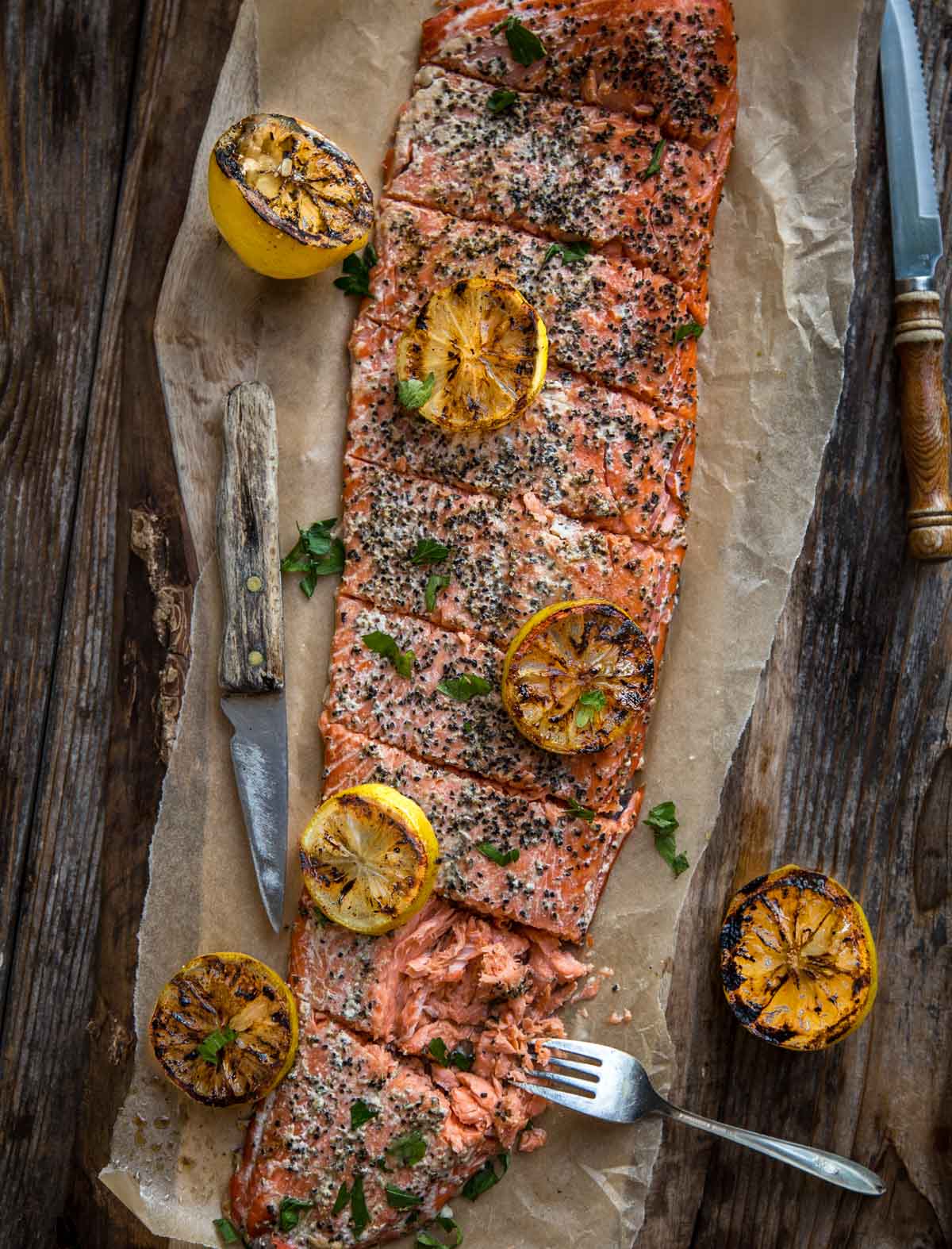
Plus they also say what grows together goes together. Pacific NW Salmon + Oregon Pinot Noir. You betcha!
Of course, there are dozens and dozens of wines that pair well with salmon but Pinot is a classic for a reason.
Leftover Smoked Salmon Ideas
This is a great recipe to make and then add the salmon to any salad or pasta dish. Some additional ideas:
**This post was originally published in July, 2017, and updated in August 2022 with new photos and answering frequently answered questions.
About Vindulge
Mary (a certified sommelier and recipe developer) and Sean (backyard pitmaster) are co-authors of the critically acclaimed cookbook, Fire + Wine, and have been creating content for the IACP nominated website Vindulge since 2009. They live in Oregon on a farm just outside Portland.
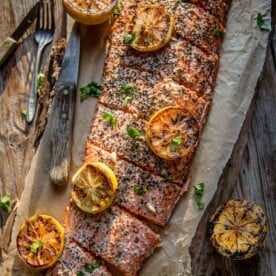
Smoked Salmon
Equipment
Ingredients
- 1 ½ pounds salmon fillet, pin bones removed, We recommend using King Salmon (Chinook).
- 1 tablespoon Dijon mustard
- 1 teaspoon kosher salt
- 1 teaspoon fresh ground pepper
Instructions
- Preheat Smoker: Set smoker to 225 degrees using fruit wood (like cherry or apple).
- Season Salmon: Coat the flesh side of salmon with the Dijon mustard, and then season with salt and pepper.
- Smoke Salmon: Place on smoker and cook until the internal temperature of the salmon reaches 135 degrees (F). If you don’t have a thermometer you can pull back the flesh and make sure the inner portion is pink and not translucent.
- Rest and Serve: Remove from smoker and let sit for 10 minutes. Slice and serve.
Video
Notes
Nutrition
Nutrition information is automatically calculated, so should only be used as an approximation.
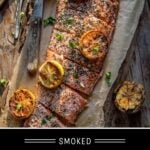
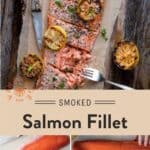
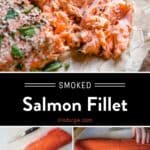
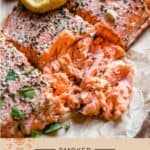
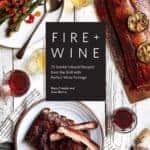

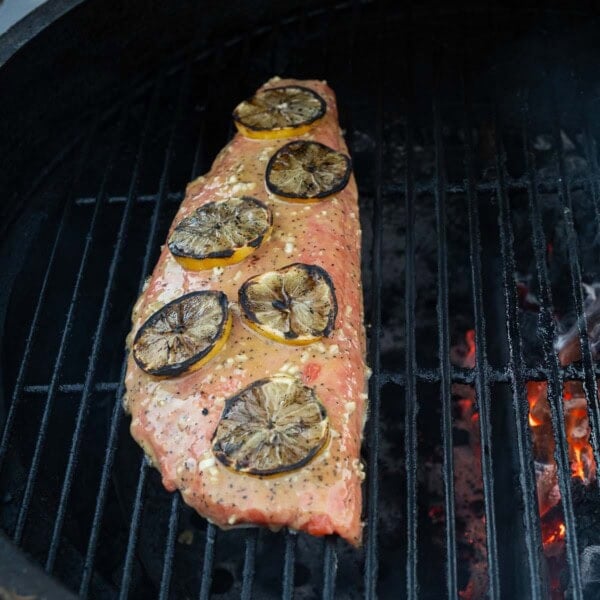
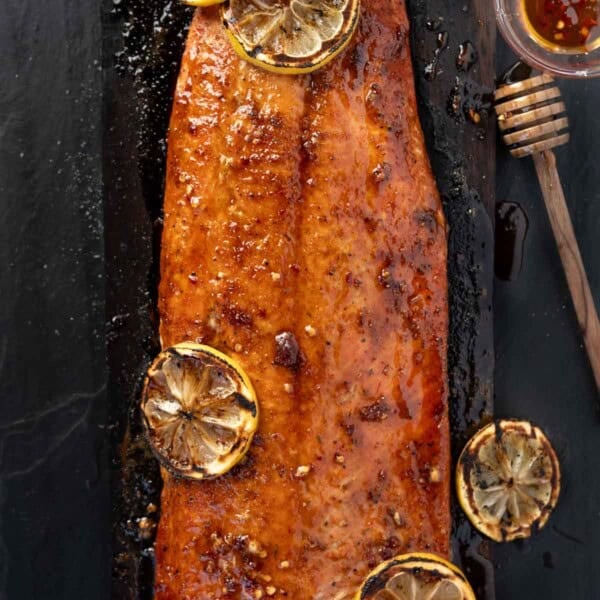
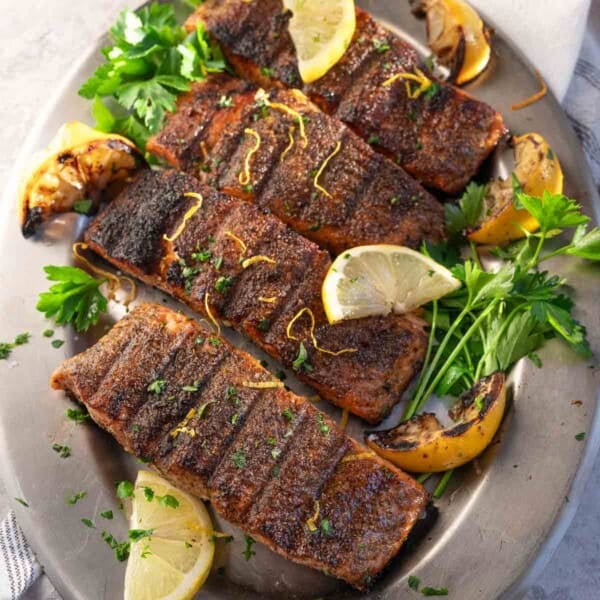
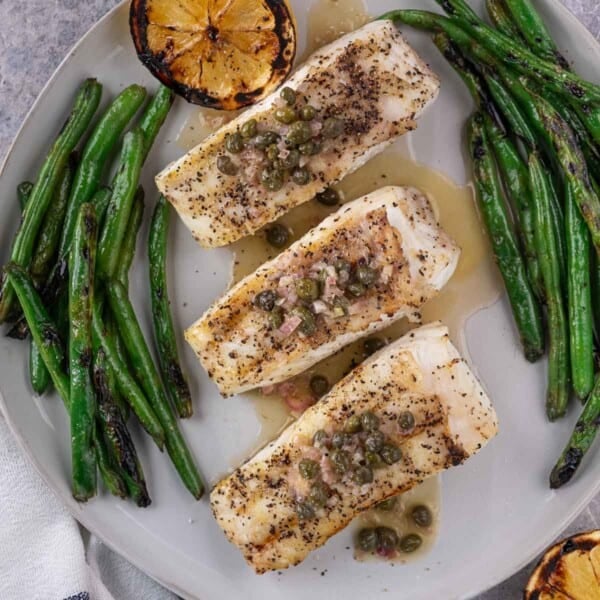
















I smoke and cook salmon all the time, use similar recipes but also smoke it for more time in the 165 smoker I built that can do about 200 lbs of salmon, Great video, you should send this to restaurant head chef’s so it’s done right, We never order salmon out because it’s always over done order it Med. rare and you get it like dried cardboard, yuck
Stony
Not gonna lie, I was skeptical of the simplicity, and the Dijon, but saw a lot of positive reviews.
And the result was: DANG, I give it an 11 out of 10 on taste, and the same for simplicity. New staple. Thanks!
Love the feedback Pete! And yes – it’s all about the flavor of the salmon and not getting in the way. And not overcooking it lol. Thanks for taking time for the feedback.
This is an excellent recipe! Comments from my wife and 3 friends were that this was some of the best smoked salmon they have ever had. And the easiest to prepare.
First try followed your recipe exactly. Second time I reduced the temperature to 180 on my Traeger for a short time to increase the smoke, but if you’re not careful it can get dry quickly. I’ll be following the recipe exactly going forward. No more need to brine!
Kevin that is awesome. I am glad to hear that this recipe turned out so well! It is always a balance for more smoke versus the moisture level. But we find this temp is the right balance of both. Thanks for sharing!